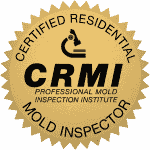Home The Residential Mold Inspection Course will get you the CRMI mold certification for doing mold testing & mold assessments in residential properties.
The Residential Mold Inspection Course will get you the CRMI mold certification for doing mold testing & mold assessments in residential properties.


PMII is an affiliate of ASHI, the American Society of Home Inspectors

PMII is an affiliate of AHI, the North American Association of Home Inspectors

IICRC Approval: 14 CREDIT HOURS of IICRC continuing education can be obtained by going through the mold training

PMII is a BBB (Better Business Bureau) A+ rated member and is authorized to display the BBB Accreditation logo

Accepted by all major homeowner insurance companies who require mold certification for water damage / restoration jobs

Approved by mold E&O insurance companies - our approved mold training qualifies for exclusive coverage from E&O providers
CRMI Residential Mold Inspector Certification



Click the add to cart button below and proceed to the checkout to get signed up. You will be emailed a username/password to login and begin.
Residential Mold Inspector Certification Course
 The Residential Mold Inspection Course will get you the CRMI mold certification for doing mold testing & mold assessments in residential properties.
The Residential Mold Inspection Course will get you the CRMI mold certification for doing mold testing & mold assessments in residential properties.Interactive self-paced online mold certification course
The PMII online mold training course features text, audio, video, images, diagrams, and flashcards to help you learn the material. As you move through the mold training, you will take lesson quizzes at the end of each lesson and a final exam online at the end of the course.The online Residential Mold Inspection Course is available on-demand
You may log in and out at your convenience!
Residential Mold Inspection Training
Mold Inspection Lessons
- Common Terminology
- Understanding Mold
- Effects on Humans
- Effects on Homes
- Detection Equipment
- Mold Sampling
- Standards of Practice
- Grounds Inspection
- Exterior Inspection
- Structure Inspection
- Plumbing Inspection
- Interior Inspection
- HVAC Inspection
- Mold Reporting
- Mold Treatment

Mold Training Course Objectives (show/hide)
PMII Mold Training Benefits (show/hide)
PMII Online Mold Training Benefits
Quality online mold training courses
- Establish a new mold business or expand your current list of services
- Industry's best mold inspection and mold remediation training
- recognized by insurance companies, state agencies, and national associations
- Affordable online mold training
- Complete courses at your own pace
Unlimited student support
- Student-instructor forum for questions
- Madison, SD support office open 12 hours-a-day
- Online support & in-house phone support
- Mold Courses / software developed and supported in-house by PMII
Get your mold business up & running
- Free 1-year subscription benefits to help get you up and running
- NAMRI membership
- Mold Inspection Report Creator software
- Free mold business website from inspectHost
- Advertising templates - customize with your information
- Use of certified logos for advertising
Course Approvals(show/hide)

PMII is an affiliate of ASHI, the American Society of Home Inspectors

PMII is an affiliate of AHI, the North American Association of Home Inspectors

IICRC Approval: 14 CREDIT HOURS of IICRC continuing education can be obtained by going through the mold training

PMII is a BBB (Better Business Bureau) A+ rated member and is authorized to display the BBB Accreditation logo

Accepted by all major homeowner insurance companies who require mold certification for water damage / restoration jobs

Approved by mold E&O insurance companies - our approved mold training qualifies for exclusive coverage from E&O providers
SALE: Special Package Price Offer!
For a limited time, get this course as part of a package dealGet all the mold certification courses together for one low price!
Mold Certification Course Package Includes:
CRMI Residential Mold Inspector Certification
CMR Mold Remediator Certification
CCMI Commercial Mold Inspector Certification



Click the add to cart button below and proceed to the checkout to get signed up. You will be emailed a username/password to login and begin.
Residential Mold Inspector Certification Course is also available through the following offer:









